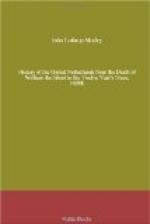And now to all appearance every chance of negotiation was gone. The half-century war, after this brief breathing space, was to be renewed for another century or so, and more furiously than ever. So thought the public. So meant Prince Maurice. Richardot and Jeannin knew better.
The departure of the commissioners was recorded upon the register of the resolutions of Holland, with the ominous note: “God grant that they may not have sown, evil seed here; the effects of which will one day be visible in the ruin of this commonwealth.”
Hardly were the backs of the commissioners turned, before the indefatigable Jeannin was ready with his scheme for repatching the rupture. He was at first anxious that the deputies of Zeeland should be summoned again, now that the country was rid of the Spaniards. Prince Maurice, however, was wrathful when the president began to talk once more of truce. The proposition, he said, was simply the expression of a wish to destroy the State. Holland and Zeeland would never agree to any such measure, and they would find means to compel the other provinces to follow their example. If there were but three or four cities in the whole country to reject the truce, he would, with their assistance alone, defend the freedom of the republic, or at least die an honourable death in its defence. This at least would be better than after a few months to become slaves of Spain. Such a result was the object of those who began this work, but he would resist it at the peril of his life.
A singular incident now seemed to justify the wrath of the stadholder, and to be likely to strengthen his party. Young Count John of Nassau happened to take possession of the apartments in Goswyn Meursken’s hostelry at the Hague, just vacated by Richardot. In the drawer of a writing-table was found a document, evidently left there by the president. This paper was handed by Count John to his cousin, Frederic Henry, who at once delivered it to his brother Maurice. The prince produced it in the assembly of the States-General, members from each province were furnished with a copy of it within two or three hours, and it was soon afterwards printed, and published. The document, being nothing less than the original secret instructions of the archdukes to their commissioners, was naturally read with intense interest by the States-General, by the foreign envoys, and by the general public.
It appeared, from an inspection of the paper, that the commissioners had been told that, if they should find the French, English, and Danish ambassadors desirous of being present at the negotiations for the treaty, they were to exclude them from all direct participation in the proceedings. They were to do this however so sweetly and courteously that it would be impossible for those diplomats to take offence or to imagine themselves distrusted. On the contrary, the States-General were to be informed that their communication in private




